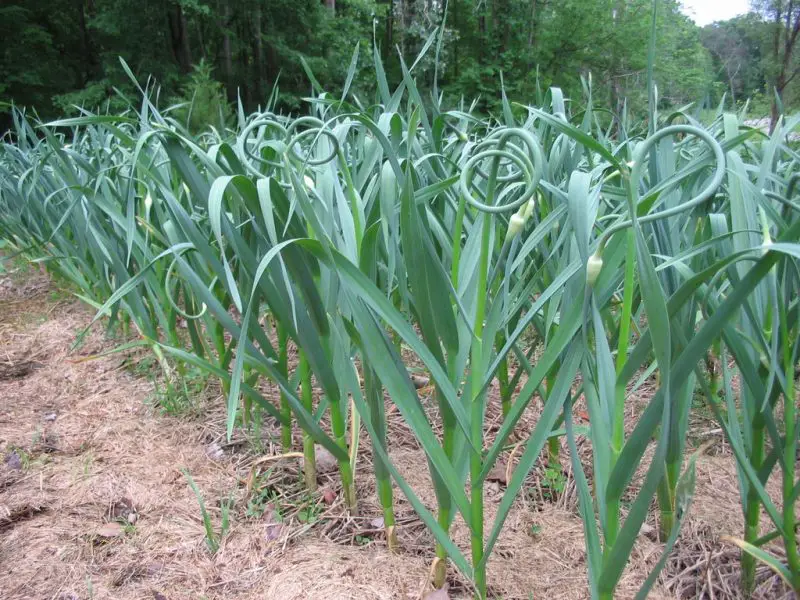Growing garlic in Michigan is a fulfilling and enjoyable gardening experience that rewards you with fresh, flavorful bulbs right from your own backyard. While Michigan’s climate brings cold winters and warm summers, these conditions are actually well-suited for garlic’s natural growth cycle, which requires a period of cold dormancy. However, successfully cultivating garlic here means understanding the state’s unique soil types, weather patterns, and seasonal rhythms.
In this guide, you’ll learn everything needed to grow garlic in Michigan like a pro—from selecting the best varieties adapted to Michigan’s environment, preparing your garden soil, and planting at the right time, to caring for your crop throughout the season and harvesting bulbs at their peak. Whether you’re a beginner or an experienced gardener, these tips will help you enjoy a bountiful garlic harvest year after year.
Get ready to unlock the secrets of growing delicious, homegrown garlic that outshines store-bought varieties in flavor, freshness, and quality. Let’s dive into the world of garlic cultivation in Michigan!
Why Grow Garlic in Michigan?

Garlic is an exceptionally hardy and adaptable crop, making it well-suited to Michigan’s unique climate conditions. Michigan’s temperate climate features cold winters with consistent snow cover and warm, moderately humid summers, creating an ideal environment for garlic to complete its natural growth cycle. One of garlic’s critical needs is a period of cold dormancy, known as vernalization, which helps stimulate bulb development. Michigan’s prolonged winter temperatures, often dropping below freezing for several months, perfectly fulfill this requirement, allowing garlic plants to thrive and produce robust bulbs.
Additionally, growing garlic at home in Michigan offers several significant benefits compared to purchasing from grocery stores. Homegrown garlic tends to be fresher, with a stronger, more complex flavor profile that is often diminished in commercially stored garlic due to long transport and storage times. Furthermore, many store-bought garlic varieties are treated with preservatives or sprouting inhibitors to extend shelf life, which can affect taste and nutritional quality. By cultivating garlic yourself, you have full control over the growing conditions, ensuring a pure, chemical-free product that retains its natural pungency and health benefits.
Moreover, garlic is a low-maintenance crop that fits well into home gardens or small-scale farms across Michigan. It requires relatively little space, thrives in well-drained soils, and benefits from the region’s spring rains and summer sunshine. Growing your own garlic also supports local biodiversity and can be part of sustainable gardening practices, reducing reliance on industrial agriculture and packaging waste. Whether you are a seasoned gardener or a beginner, Michigan’s climate provides a perfect opportunity to enjoy the rewards of fresh, homegrown garlic.
Understanding Michigan’s Climate and Its Impact on Garlic Growth
Michigan’s climate plays a crucial role in the successful cultivation of garlic. The state experiences a distinct four-season pattern, with cold, snowy winters and warm, humid summers. This seasonal variation aligns well with garlic’s growth cycle, particularly its need for a cold period to initiate bulb formation. However, understanding the specifics of Michigan’s climate zones and how the winter cold influences garlic development is essential to optimize planting and harvesting.
Michigan’s Growing Zones and Garlic Hardiness
Michigan spans USDA hardiness zones 4a to 6a, with the majority of the state situated in zones 5 and 6. These zones indicate the average annual minimum winter temperatures, which range from approximately -30°F (-34°C) in zone 4a to about -10°F (-23°C) in zone 6a. Garlic generally grows well in zones 4 through 9, making Michigan’s climate well-suited for cultivating various garlic types. Both softneck garlic, which is more common in warmer climates, and hardneck garlic, which thrives in colder areas, can be grown successfully here. However, due to Michigan’s cold winters, hardneck varieties such as Rocambole, Porcelain, and Purple Stripe are often preferred because of their superior cold tolerance and complex flavors.
How Winter Cold Affects Garlic
One of the most critical factors in garlic cultivation is exposure to cold temperatures during winter, a process called vernalization. This cold period signals the garlic cloves to break dormancy and begin developing bulbs in the spring. In Michigan, planting garlic cloves in the fall ensures they experience sufficient chilling as the soil temperatures drop. However, Michigan winters can be severe, with freezing temperatures sometimes extending into early spring. To protect garlic from freeze damage and fluctuating temperatures, gardeners must time planting carefully—typically in late September to early November—and apply a thick layer of mulch. Mulching helps insulate the cloves, maintaining consistent soil temperatures and preventing frost heaving, which can disturb root development.
Choosing the Right Garlic Variety for Michigan
Selecting the appropriate garlic variety is essential for successful cultivation in Michigan’s climate. Because Michigan experiences cold winters, it is important to choose garlic types that can tolerate freezing temperatures and still produce healthy, flavorful bulbs. While some varieties thrive naturally in colder regions, others may require additional care or protection during winter months.
Hardneck vs. Softneck Garlic
Garlic generally falls into two main categories: hardneck and softneck. Hardneck garlic is better suited for colder climates like Michigan. One of its distinguishing features is the production of a flower stalk, known as a scape, which gardeners can harvest and enjoy. This variety tends to have a stronger, more robust flavor compared to softneck garlic. Its natural cold hardiness allows it to survive Michigan’s harsh winters and benefit fully from the essential cold period needed for bulb development.
On the other hand, softneck garlic is more commonly grown in milder climates. It usually stores longer than hardneck varieties, making it popular in commercial production. However, softneck garlic is less tolerant of extreme cold, so in Michigan, it may need extra winter protection such as thick mulching to survive the freezing temperatures. Despite this, some softneck types can still be grown successfully with proper care.
Recommended Garlic Varieties for Michigan
Among hardneck garlics, the Rocambole variety is highly regarded for its rich, deep flavor and excellent tolerance to cold weather, making it a favorite among Michigan gardeners. Music garlic is another popular hardneck type that produces large, flavorful bulbs well-adapted to Michigan’s growing conditions. German Red garlic offers both hardiness and a bold flavor profile that suits the regional climate perfectly. Inchelium Red is also a hardneck variety known to perform well in colder zones similar to Michigan.
For those interested in softneck garlic, Silverskin is a variety that can grow in Michigan but typically requires extra winter protection due to its lower cold tolerance. With careful mulching and site selection, Silverskin garlic can still be a viable option for home gardeners seeking a milder flavor and longer storage life.
Preparing Your Michigan Garden for Garlic
Successful garlic cultivation begins long before planting. Proper preparation of your garden site and soil is essential to create optimal conditions for healthy garlic growth. Michigan’s diverse soil types and climate require gardeners to carefully select the planting location and amend the soil to meet garlic’s specific needs.
Selecting the Ideal Planting Site
Garlic grows best in a site that receives full sun, ideally around six to eight hours of direct sunlight each day. Sunlight is crucial because garlic needs plenty of energy for bulb development. When choosing a spot, avoid low-lying areas where water tends to pool after rainfall or snowmelt, as excessive moisture can lead to root rot and fungal diseases. Instead, select well-drained, elevated areas where water drains quickly but the soil retains enough moisture to support growth.
Soil Preparation for Garlic
Soil conditions in Michigan can vary significantly, ranging from sandy soils to heavy clay. Garlic prefers soil that is loose and fertile with good drainage to prevent waterlogging. The ideal soil pH for garlic is slightly acidic to neutral, between 6.0 and 7.0. It is important to test your garden soil’s pH before planting. If the soil is too acidic, applying lime can help raise the pH, whereas sulfur amendments can lower the pH if it is too alkaline.
Improving soil fertility is equally important. Incorporating generous amounts of well-aged compost or manure enriches the soil with organic matter and nutrients that garlic needs for vigorous growth. Organic amendments also help improve soil structure, making heavy soils lighter and sandy soils better able to retain moisture.
For gardeners dealing with heavy clay soils common in some parts of Michigan, drainage can be a challenge. In such cases, building raised beds filled with a mix of native soil, compost, and coarse sand or organic matter is highly recommended. This approach ensures the roots have adequate aeration and reduces the risk of standing water, creating the ideal environment for garlic bulbs to develop strong and healthy.
When and How to Plant Garlic in Michigan
Planting garlic at the right time and following proper planting techniques are key to ensuring a healthy and productive crop in Michigan’s climate. Understanding the best window for planting and how to prepare the cloves will give your garlic the best start before winter arrives.
Best Planting Time
In Michigan, the ideal time to plant garlic is typically from early to mid-October. This timing allows the garlic cloves to establish a strong root system before the ground freezes. Planting approximately four to six weeks before the first expected hard frost ensures the cloves have enough time to develop roots while remaining dormant through the cold winter months. Planting too early can cause premature shoot growth, which may be damaged by frost, while planting too late might prevent adequate root establishment.
Preparing Garlic Cloves for Planting
Before planting, garlic bulbs need to be separated into individual cloves. It’s important to leave the papery skins intact on each clove, as they protect the cloves from rot and disease. When selecting cloves for planting, choose the largest and healthiest ones, since these will generally produce the biggest and best-quality bulbs by the end of the growing season. Smaller cloves tend to produce smaller bulbs and may not perform as well.
Planting Depth and Spacing
Plant each garlic clove with the pointed end facing upward, about two inches deep into the soil. This depth helps protect the cloves from cold and encourages strong root development. The cloves should be spaced about four to six inches apart within rows, allowing enough room for the bulbs to grow to full size. Rows themselves should be spaced between twelve to eighteen inches apart, which provides adequate air circulation and ease of access for maintenance tasks such as weeding and watering.
After placing the cloves in the soil, cover them with soil and water thoroughly. The initial watering helps settle the soil around the cloves and jumpstarts root development. Following these planting guidelines will set the foundation for a successful garlic crop in Michigan.
Caring for Garlic During the Growing Season in Michigan
Proper care throughout the growing season is essential to produce healthy, flavorful garlic bulbs in Michigan. This includes managing watering, mulching, fertilizing, and pest control according to the specific needs of garlic in a temperate climate.
Watering
Maintaining consistent soil moisture is important for garlic, but it is equally crucial to avoid overwatering. The soil should feel moist to the touch but never soggy, as waterlogged conditions can promote bulb rot and fungal diseases. As the garlic plants near maturity and the harvest period approaches, gradually reduce watering to allow the bulbs to dry out properly. This helps prevent rot and improves the storage life of harvested garlic.
Mulching for Protection and Weed Control
After planting in the fall, applying a thick layer of mulch—about three to four inches of straw or shredded leaves—serves multiple purposes. Mulching insulates the garlic during Michigan’s harsh winters, helping to protect the cloves from extreme cold and frost heaving. During the growing season, mulch also suppresses weeds that compete with garlic for nutrients and water. It helps retain soil moisture and creates a more stable soil environment for healthy growth.
Fertilizing
Garlic responds well to nitrogen-rich fertilizers, especially in early spring when growth resumes after winter dormancy. Applying a balanced fertilizer or organic alternatives such as fish emulsion or compost tea provides essential nutrients to encourage vigorous leaf and bulb development. However, it is important to avoid excessive fertilization, as too much nitrogen can lead to lush leafy growth at the expense of bulb size and quality. Applying fertilizer according to soil test recommendations is the best practice to ensure the right nutrient balance.
Managing Pests and Diseases
Several pests can threaten garlic crops in Michigan, including onion maggots, nematodes, and thrips. Crop rotation is one of the most effective strategies to reduce the buildup of pests and diseases in the soil, so avoid planting garlic or other alliums in the same location year after year. If infected plants are identified, promptly remove and destroy them to prevent the spread of disease. Using row covers can protect young garlic plants from pests, reducing damage during the vulnerable early stages of growth.
Recognizing Garlic Growth Stages
Understanding the growth stages of garlic helps gardeners monitor plant health and know when to intervene for optimal results. In Michigan, garlic follows a clear seasonal pattern from early spring through harvest.
Spring Growth
As temperatures rise in early spring, garlic breaks dormancy and resumes active growth. During this period, new green leaves emerge from the soil, signaling that the plant is focusing on developing its foliage and roots. This stage is critical for photosynthesis, which builds the energy necessary for strong bulb development later in the season. Proper watering and fertilization at this time support vigorous leaf growth.
Scape Formation (for Hardneck Varieties)
Around late May to early June, hardneck garlic plants begin producing a flower stalk known as a scape. The scape is a curly, green shoot that grows from the center of the plant and eventually produces flowers. Removing the scapes once they start to curl is beneficial because it redirects the plant’s energy away from flowering and toward enlarging the garlic bulbs underground. This practice typically results in larger and more flavorful bulbs at harvest.
Bulb Maturation
Throughout the summer months, garlic bulbs mature gradually beneath the soil. As the bulbs grow, the leaves begin to yellow and die back, indicating that the plant is nearing the end of its growth cycle. Monitoring leaf color and texture provides important clues about the best time to harvest. When about half to two-thirds of the leaves have turned yellow or brown, it usually signals that the bulbs have reached optimal maturity and are ready to be dug up.
Harvesting Garlic in Michigan
Knowing the right time and technique for harvesting garlic ensures you preserve the quality and longevity of your crop. Michigan’s climate and growing conditions influence the harvest window and the best practices for digging up your garlic bulbs.
When to Harvest
In Michigan, garlic is usually ready to be harvested in mid to late July. The key indicator for harvest readiness is the condition of the leaves. You should harvest when the lower leaves have started turning brown and dry, while there are still about five to six green leaves remaining near the top of the plant. This timing strikes the perfect balance between bulb maturity and quality. Waiting too long to harvest can cause the garlic bulbs to split, which reduces their storage life and overall flavor. Harvesting at the right time ensures your garlic will store well through the winter months.
How to Harvest
To harvest garlic, begin by loosening the soil around the bulbs carefully using a garden fork. Insert the fork a few inches away from the plants to avoid damaging the bulbs, then gently lift them out of the ground. Handle the bulbs carefully to prevent bruising or cuts, as damaged garlic will not store well and is more susceptible to rot.
Once lifted, shake off any excess soil from the bulbs but avoid washing them with water. Washing can introduce moisture that promotes mold and decay during storage. Instead, allow the garlic to dry naturally in a well-ventilated, shaded area before curing.
Curing and Storing Garlic for Long-Term Use
Proper curing and storage are essential steps to maximize the shelf life and quality of your garlic harvest. These processes allow the bulbs to dry out sufficiently and maintain their flavor and firmness for many months.
Curing Process
After harvesting, garlic bulbs should be laid out in a warm, dry, and well-ventilated area that is protected from direct sunlight. Good air circulation helps prevent mold and rot during the curing process. The bulbs need to cure for about two to four weeks until their outer skins become papery and the necks dry completely. Proper curing not only enhances the garlic’s flavor but also prepares it for long-term storage by reducing moisture content and strengthening the bulb’s protective layers.
Proper Storage Conditions
Once fully cured, garlic should be stored in breathable containers such as mesh bags, baskets, or hanging braids. These allow air to circulate freely around the bulbs, preventing moisture buildup that could cause spoilage. The ideal storage temperature is between 60 and 65 degrees Fahrenheit, with moderate humidity to keep the garlic firm without encouraging sprouting. It is important to avoid refrigeration, as cold temperatures can trigger premature sprouting and shorten the garlic’s shelf life. When cured and stored correctly, garlic can remain fresh and flavorful for up to nine months, providing you with a steady supply throughout the year.
Troubleshooting Common Problems Growing Garlic in Michigan
While garlic is generally a resilient crop, growers in Michigan may encounter certain challenges related to soil conditions, pests, and nutrient management. Recognizing these issues early and taking preventive measures can help ensure a successful harvest.
Garlic Rot and Mold
One of the most common problems is rot and mold, which usually result from overly wet soil or poor drainage. Michigan’s variable soil types and heavy rains can create conditions where water accumulates around the garlic bulbs, promoting fungal growth and decay. To prevent these issues, it is advisable to plant garlic in raised beds or well-draining soil. Avoid overwatering throughout the growing season, and apply mulch carefully to maintain moisture without waterlogging. Good soil aeration and drainage are essential to keep the roots healthy and free from rot.
Pests
Several pests can affect garlic plants in Michigan. Onion maggots are known to damage garlic roots, weakening the plants and reducing bulb size. To manage these pests, crop rotation is critical—avoid planting garlic or related alliums in the same spot year after year. Using insect netting or row covers can also provide physical protection against adult flies laying eggs near the bulbs.
Thrips are another common pest that cause leaf damage by feeding on the plant’s sap, leading to silvery streaks and reduced vigor. Control measures for thrips include the use of insecticidal soaps or organic treatments such as neem oil, which help reduce pest populations without harming beneficial insects.
Poor Bulb Development
If garlic bulbs fail to develop properly, the cause is often related to planting practices or nutrient deficiencies. Using small or damaged cloves as seed garlic typically results in smaller, less robust bulbs. It is important to select large, healthy cloves for planting to encourage vigorous growth. Additionally, insufficient soil fertility can limit bulb size and quality. Applying the appropriate amount of fertilizer, particularly nitrogen in early growth stages, supports strong leaf and bulb development. Regular soil testing can help tailor nutrient applications to the specific needs of your garden.
Advanced Tips for Growing Garlic Like a Pro Gardener in Michigan
For gardeners looking to take their garlic cultivation to the next level, employing some advanced techniques can improve yields, enhance bulb quality, and create a more sustainable growing cycle year after year.
Saving Your Own Seed Garlic
One of the best ways to ensure strong, well-adapted garlic crops is to save your own seed garlic from each harvest. Select the largest, healthiest bulbs when you dig up your garlic, as these tend to produce the most vigorous plants. Store these bulbs properly in a cool, dry, and well-ventilated area until fall planting. Replanting your own seed garlic each year helps develop strains that are specifically acclimated to Michigan’s unique climate and soil conditions, often resulting in better growth and flavor.
Companion Planting
Garlic is a natural pest repellent, making it an excellent companion plant in your garden. It can be planted near roses, tomatoes, and fruit trees to help deter common pests such as aphids and spider mites. This natural defense reduces the need for chemical pesticides and promotes a healthier garden ecosystem. However, it’s best to avoid planting garlic near beans and peas, as garlic can inhibit their growth due to allelopathic effects, which negatively affect nitrogen-fixing plants.
Extending the Growing Season
To maximize your garlic’s growth potential in Michigan’s variable climate, consider using cold frames or row covers in early spring. These tools help warm the soil and protect young shoots from late frosts, encouraging faster growth and an earlier start to the season. Additionally, applying a heavy layer of mulch during winter protects garlic bulbs from harsh freeze-thaw cycles, which can damage developing roots and reduce bulb size. Proper winter protection ensures stronger, healthier plants come spring.
Conclusion
Growing garlic in Michigan can be straightforward and highly rewarding with the right knowledge and techniques. By selecting cold-hardy varieties, preparing your soil well, planting at the right time, and carefully caring for your garlic throughout the seasons, you can harvest abundant, flavorful bulbs. Follow this pro gardener guide to enjoy fresh Michigan-grown garlic that enhances your cooking and your garden.






